Ecological connectivity can be successfully included in EIAs – study

In a series of recent papers, an international team of researchers presents evidence around the benefits of considering ecological connectivity in environmental impact assessment.
Connectivity refers to the degree to which a natural landscape remains unbroken by a development project, be it a road, mine, transmission line or hydro dam. These projects have the potential to impede wildlife movement with important consequences for migration, genetic diversity, population abundance, climate resilience, disease resistance and more.
Looking at five different projects in Canada, the UK, Sweden and Spain, the study found commonalities of challenges, lessons learned and important future research directions.
The 15 challenges encountered touched on the limited awareness and understanding of the importance of connectivity among environmental impact assessment practitioners; technical problems such as a lack of quality data and difficulty in transferring knowledge between scientists and practitioners; and a need for better coordination between authorities across jurisdictions.
As for the 19 lessons learned, the case studies show that connectivity assessments should be based on scientific knowledge such as ecological characteristics and the need to consider multiple scales of analysis.
The researchers also note that thinking about connectivity early in the EIA process benefits the overall development and reveals potential threats. The case studies demonstrate that various pathways, and not just one, can lead to the successful inclusion of connectivity.
Guidance needed
The case studies all reveal the need for guidance on when, why and how to conduct connectivity analyses, and which techniques or tools should be used. They also identify the need for monitoring to see if the projects’ restoration and conservation efforts attain their goals.
The researchers hope that the papers, which were part of a special issue of the journal Impact Assessment and Project Appraisal, will lead to legislation that requires connectivity considerations to become mandatory in EIAs, and that governments enact regulatory frameworks to maintain appropriate standards and enforcement measures.
“After presenting our research as part of an online workshop, the original core purpose of improving the consideration of ecological connectivity in EIA became the foundation of a working group,” lead author Charla Patterson said. “These are people from multiple countries, working across different sectors in EIA who volunteered their time over the last couple of years because they believe in the importance of this work.”
Patterson also found encouraging the fact that professionals across different sectors recognized the importance of connectivity and agreed that it should be included in environmental impact assessments.
{{ commodity.name }}
{{ post.title }}
{{ post.date }}

Comments